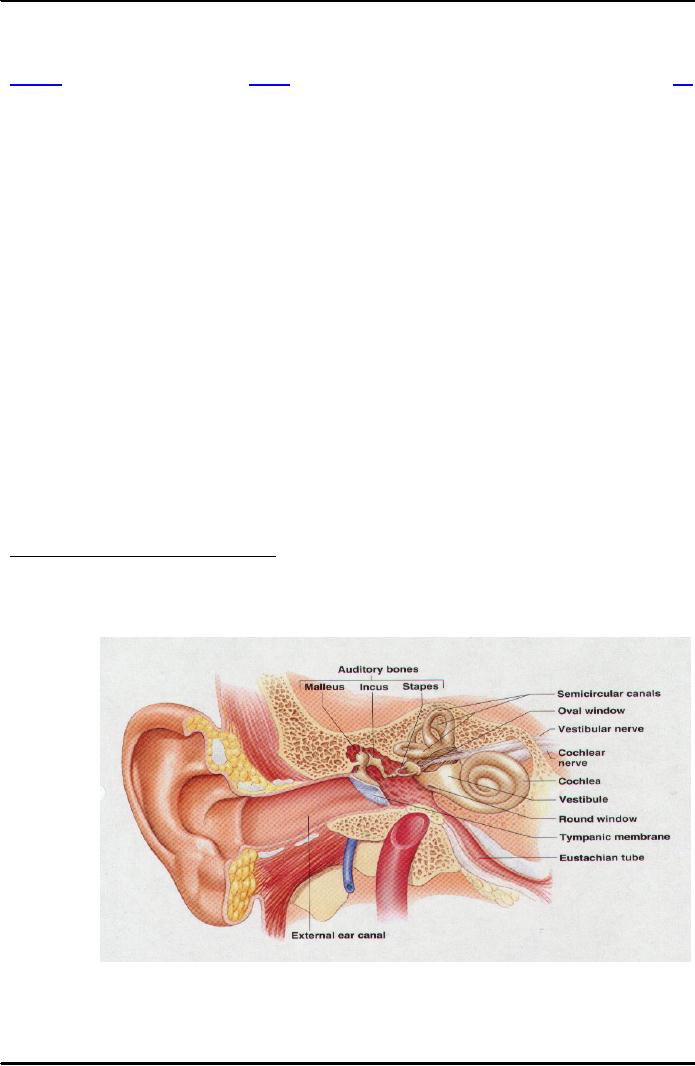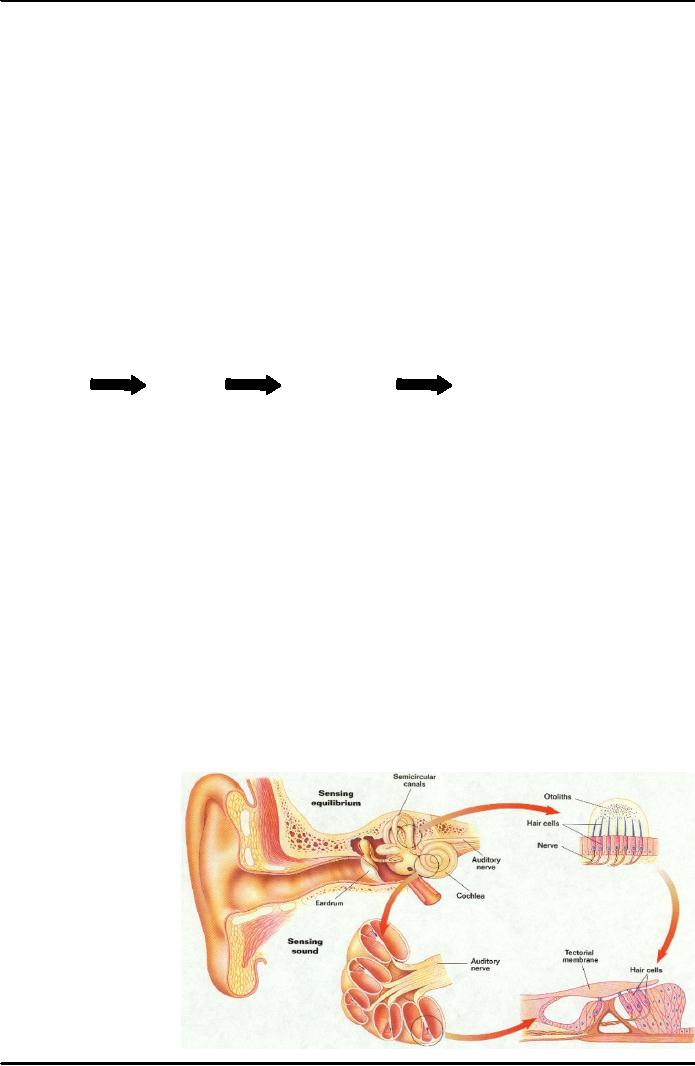 |
HEARING (AUDITION) AND BALANCE:The Outer Ear, Auditory Canal |
| << SENSATION:The Human Eye, Cornea, Sclera, Pupil, Iris, Lens |
| PERCEPTION I:Max Wertheimer, Figure and Ground, Law of Closure >> |

Introduction
to Psychology PSY101
VU
Lesson
16
HEARING
(AUDITION) AND BALANCE
Hearing
or
audition is the sense of sound
perception
and results from tiny
hair fibers in the inner ear
detecting
the motion of a membrane which
vibrates in response to changes in the
pressure
exerted
by atmospheric particles within
(at best) a range of 20 to
20000 Hz. Sound can
also
be
detected as vibrations conducted
through the body by tactician.
Lower and higher
frequencies
than can be heard are
detected this way only. The
main features regarding ear
are:
�
Ear is
regarded as the organ of
hearing.
�
Like
our other senses, our
hearing or audition, is highly
adaptive
�
Sense
of motion and balance is
regarded as the main and
important function of the
ear
�
Organisms
have the ability to hear a wide
range of sounds with
different frequencies (ranging
from
higher
to very low faint voice)__ but
more importantly we can
easily detect different
voices of
people
whom we know or met
�
For
this, the important question is how we do
it? How the transformation of
sound waves into
neural
messages takes place?
Some
Interesting Facts about Hearing
�
Animals
have the capability of hearing more
sounds than humans
�
Dolphins
have the best sense of
hearing among all
animals
�
When
people go up high in the mountains, the
changes in pressure cause the
ear to pop
�
Babies
can get ear aches
because of the milk deposit in the
eustachian tube, which helps
the
bacteria
to grow there and may
cause problems later in
life
�
Children
can hear more noises
than adults, as their ears
are more sensitive than
that of adults
�
Ear
aches result when too
much fluid causes pressure
in the eardrum__ often occur
due to
allergies,
virus or some sort of infection
The
Human Ear: Anatomy/
Structure
The
primary apparatus of hearing i.e., the
ear is divided into three
parts
1.
The outer ear
2.
The middle ear
3.
The inner ear
1.
The Outer Ear
�
The
outer ear serves the
function of collecting the sound waves
from the environment to the
internal
portions of the ear. It is shaped
like a reverse
megaphone
�
It
also plays an important role
in locating the sound direction from
which it originates
98

Introduction
to Psychology PSY101
VU
Auditory
Canal
�
When
sound waves originate from the
vibrating object, they then pass
through the auditory
canal,
which
is a tube like passage through
which the sound travels to the
inner part of the ear or "
the
eardrum".
Eardrum
�
The
part of the ear that starts
vibrating when sound waves
strike/ hit it.
�
Its
intensity of vibration is dependent on
how intense the sound waves
are___ the more intense
the
sound,
the more intensely it
vibrates.
�
These
vibrations are then transmitted to the "
middle ear".
2.
Middle Ear
�
A
tiny chamber between the
eardrum and cochlea
containing three bones---- the
hammer, the anvil,
and
the
stirrup, which transmit vibrations to the
oval window.
�
These
three bones have only
one function, i.e. to
convey/ transmit the message to the inner
ear.
These
bones are also effective in the
sense that they strengthen the
stimulus (vibration) so that it
can be
easily
heard. Information (Vibration) Travels
Through These Three
Bones
Hammer
Anvil
Stirrup
Oval
window
Oval
Window
�
A
membrane between the middle
and the inner ear that
increases the strength of the stimulus
(vibration)
while
transmitting them.
�
Serves
as the amplifier so that tiny or
hiss voices could be heard,
which otherwise may remain
unnoticed.
3.
Inner Ear
�
The
innermost region/ part of the ear
that contains important
structures such as cochlea,
semi
circular
canals and vestibular sacs,
and that changes/ transforms
the sound waves into the
neural
impulse.
�
Organs
that are present in it help
us to determine in locating our position
and how we are
moving
in
space.
�
In the
inner ear, the sound enters
into the cochlea___ a coiled, bony tube
filled with the fluid
that
receives
information (sound) from the
oval window or through bone conduction.
The sound waves
that
reach here help in triggering the
nerve impulse. Basal
Membrane
�
Inside
the cochlea is the basal membrane
passing from the middle of
cochlea___ a structure
that
divides
the cochlea into the upper and
lower chambers/ parts.
�
This
basal membrane is covered/ surrounded by
the tiny hair cells that
are bent on the vibration,
so
that
neural message reaches the
brain without any hindrance
or difficulty; helps to transmit
information
to the temporal lobe's auditory
region.
�
Another
means
of
hearing sound
besides
cochlea
is
through bone
conduction.
As
ear
is directly
connected
with
the
skull's bones,
the
cochlea is
then
able to
pickup
subtle
voices
(such as
one's
own
voice).
This is
largely
due to
99

Introduction
to Psychology PSY101
VU
bone
conduction. Why one's own voice seems
different to one's self than
to others is due to this
phenomenon.
This may also occur because
voice reaches one's self
through the air and
also
through
bone conduction.
Sound
and Its Physical and Psychological Aspects and
Impacts
�
Sound
is the primary stimulus for
hearing.
�
Sound
actually refers to the physical movement
of air molecules in regular and
wave like pattern/
sequence.
�
When
an object creates/ produces sound, it
results in the back and
forth vibration of its
surface,
creating
sound waves in the surrounding air.
These dense and thin
sound waves serve as
the
stimulus
for the ear/ for hearing
process.
�
Sound
waves that are being produced
differ in their intensity, amplitude,
frequency and
complexity___
they afterwards produce corresponding
dimensions of sound. i.e.
pitch, volume and
timbre.
Frequency
�
Frequency
is the prominent feature/ characteristic
of sound and refers to the number of
complete
wave
lengths/ crests that occur
or pass a point in each
second.
�
In
low frequency of sounds,
there are relatively fewer
and slower up- and-
down wave patterns
per
second__
these low frequencies are
then translated in what is called "
pitch".
Pitch
�
Primarily
related with the frequency
and refers to the quality of
sound that is being produced by
the
frequency
of the sound wave; expressed in
cycles per second__ the
trait that makes the
sound
"high"
or " low".
�
The
lowest and highest
frequencies that humans can
hear range from 20 cycles
per second to
20,000
cycles per second.
Volume/
Intensity/ Loudness
�
Volume
or loudness can be described as "
strong" or " weak"__ determined by the amount
of
pressure
difference between the compressed part of
the sound wave and the
prominent part
�
Waves
that have low peaks
create soft sound as
compared to the waves with higher
peaks
�
The
range within which humans
can hear is extensive
measured in unit called
decibel (db).
�
If the
sound exceeds 120 decibels
then it become painful to
human ear.
Timbre
�
When
fundamental tones are combined with the
weaker tones, they are then
to be known as over
tones.
�
Partials
and harmonic tones are the audible
tones that help to make up
timbre__ quality of
sound
determined
by the complexity of sound
waves
�
The
difference in quality or timbre is determined by the
complexity and arrangements of
the
overtones
that any instrument/ object
produces which largely
depends on its design and
material
from
which it is made.
Theories
of Hearing/ Theories of Pitch
Perception
Place
Theory of Hearing
�
The
most frequent question that
comes to mind is that how
can our brain sort out the
sound waves
of
different frequencies and
intensities without any hindrance or
problem?
�
The
answer lies in the studies done in this
regard. They show that the
basal membrane (inner
most
region
of the ear near the cochlea)
and its associated areas
are most sensitive to high
pitched
frequency
sounds, and the area near
the cochlea is more sensitive to
low- frequency
sounds.
100

Introduction
to Psychology PSY101
VU
�
The
findings of these studies led to the
formation of place theory of
hearing, which says
that
different
areas in the basal membrane
respond to different frequencies of
sound; pitch
corresponds
to
the location of greatest stimulation
along the basilar membrane.
�
The
most important shortcoming of this theory
is that it is unable to explain the
process of hearing,
i.e.
sounds of low frequencies
also trigger the neurons in the basal
membrane and its
associated
areas.
�
Due
to this incomplete explanation of auditory phenomena,
an additional explanation came in
the
form
of " frequency theory of
hearing".
Frequency
Theory of Hearing
�
This
theory explains that the entire
basal membrane acts as a microphone,
vibrating in response to
sound
i.e. activation occurs in the
whole area in response to the
vibration.
�
The
theory tends to explain that the
nerve impulses in that region
are directly
connected/
associated
with the frequencies of sound to
which they are exposed___ so the higher
the pitch of
the
sound, the more the nerves trigger
and send messages to the
brain.
�
Both
theories are important and
useful in the sense that they
provide the accurate description
of
the
whole auditory phenomena.Specifically,
place theory gives a better explanation
of processing
the
high- frequency sounds and
frequency theory tells us
that how the low- frequency
sounds are
encountered
and dealt with.
Auditory
Information Processing
�
After
leaving the ear, the auditory message is
directly transmitted to the auditory cortex of the
brain
with
the complex series of neural
interconnections
�
Within
the cortex, there are neurons
that respond to selective
sounds having specific
features___
there
are neurons also that
respond only to specific
pattern/ sort of sounds and
not to the
intermittent
sounds.
�
Auditory
cortex provides us with the " map" of
sound frequencies that
furnishes our response
to
the
environmental stimuli.Auditory/
Hearing Damage
�
Auditory
damage occurs largely due to
the following three major reasons
besides some others:
1.
Prolonged exposure to loud
noise
2.
Severe/ hard blow to the ear sensitive
regions
3.
Old age
(Others
include illness, or damage to the middle
or inner ear)
1.
Prolonged Exposure to the Loud
Noise
�
It is
also called stimulation
deafness
�
It
includes various types of
loud tones/ sounds such as
speech, music,
machinery,
�
and
other complex sounds
�
The
damage is irreversible as the receptors
which are damaged do not
regenerate
�
Large
amount of damage occurs between the
frequency of 1000 Hz to 2000
Hz
2.
Severe/ Hard Blow to the
Ear Sensitive
Regions
�
Tinnitus
refers to a "ringing in the ears"
____ it is usually a high-pitched
tone.
�
The
origins of it may lie in either extreme
stimulation (above 130 db)
or in vascular
�
blockage,
or in muscle spasms i.e., in the tympanic
muscles.
3.
Old Age
�
As people
progress towards their old
age, their hearing capability
weakens in higher
frequency
ranges. This is primarily
due to an over all
degeneration .
�
Environmental
factors also play role in
causing auditory damage along
with old age.
Types
of Hearing Impairment
1.
Conduction Deafness: problem in
conduction of air vibrations to the
cochlea; the bones in the
middle
ear do not function
properly.
Treatment:
microsurgery for replacing the
affected bone with an artificial
one.
101

Introduction
to Psychology PSY101
VU
2.
Nerve Deafness: deafness
caused by a damage to the neural
mechanism that creates nerve
impulses
or
relays them to the auditory cortex;
deafness may also be caused
by a damage to the auditory cortex
itself.
Balance
and the Role of
Ear
�
Several
ear structures are related
with the sense of balance of the
person much more than
playing their
roles
in hearing phenomena
�
Three
tubes or the semi circular
canals (inner ear) contain the
fluid that moves when the
head moves;
the
rotational or angular movements
are signaled to the brain.
The
semicircular canals contain otoliths
that are tiny motion-
sensitive crystals. The
otoliths can sense
the
pull
on our body exerted by
gravity, as well as that by the
acceleration of forward, backward, or
up-and-
down
motion. When the person
moves these crystals also
move. Thus the system is
familiar with the feeling
in
case of different moves, and
constantly strives for a perfectly
balanced position; the otoliths
can sense
immediately.
102
Table of Contents:
- WHAT IS PSYCHOLOGY?:Theoretical perspectives of psychology
- HISTORICAL ROOTS OF MODERN PSYCHOLOGY:HIPPOCRATES, PLATO
- SCHOOLS OF THOUGHT:Biological Approach, Psychodynamic Approach
- PERSPECTIVE/MODEL/APPROACH:Narcosis, Chemotherapy
- THE PSYCHODYNAMIC APPROACH/ MODEL:Psychic Determinism, Preconscious
- BEHAVIORAL APPROACH:Behaviorist Analysis, Basic Terminology, Basic Terminology
- THE HUMANISTIC APPROACH AND THE COGNITIVE APPROACH:Rogers’ Approach
- RESEARCH METHODS IN PSYCHOLOGY (I):Scientific Nature of Psychology
- RESEARCH METHODS IN PSYCHOLOGY (II):Experimental Research
- PHYSICAL DEVELOPMENT AND NATURE NURTURE ISSUE:Nature versus Nurture
- COGNITIVE DEVELOPMENT:Socio- Cultural Factor, The Individual and the Group
- NERVOUS SYSTEM (1):Biological Bases of Behavior, Terminal Buttons
- NERVOUS SYSTEM (2):Membranes of the Brain, Association Areas, Spinal Cord
- ENDOCRINE SYSTEM:Pineal Gland, Pituitary Gland, Dwarfism
- SENSATION:The Human Eye, Cornea, Sclera, Pupil, Iris, Lens
- HEARING (AUDITION) AND BALANCE:The Outer Ear, Auditory Canal
- PERCEPTION I:Max Wertheimer, Figure and Ground, Law of Closure
- PERCEPTION II:Depth Perception, Relative Height, Linear Perspective
- ALTERED STATES OF CONSCIOUSNESS:Electroencephalogram, Hypnosis
- LEARNING:Motor Learning, Problem Solving, Basic Terminology, Conditioning
- OPERANT CONDITIONING:Negative Rein forcer, Punishment, No reinforcement
- COGNITIVE APPROACH:Approach to Learning, Observational Learning
- MEMORY I:Functions of Memory, Encoding and Recoding, Retrieval
- MEMORY II:Long-Term Memory, Declarative Memory, Procedural Memory
- MEMORY III:Memory Disorders/Dysfunctions, Amnesia, Dementia
- SECONDARY/ LEARNT/ PSYCHOLOGICAL MOTIVES:Curiosity, Need for affiliation
- EMOTIONS I:Defining Emotions, Behavioral component, Cognitive component
- EMOTIONS II:Respiratory Changes, Pupillometrics, Glandular Responses
- COGNITION AND THINKING:Cognitive Psychology, Mental Images, Concepts
- THINKING, REASONING, PROBLEM- SOLVING AND CREATIVITY:Mental shortcuts
- PERSONALITY I:Definition of Personality, Theories of Personality
- PERSONALITY II:Surface traits, Source Traits, For learning theorists, Albert Bandura
- PERSONALITY III:Assessment of Personality, Interview, Behavioral Assessment
- INTELLIGENCE:The History of Measurement of Intelligence, Later Revisions
- PSYCHOPATHOLOGY:Plato, Aristotle, Asclepiades, In The Middle Ages
- ABNORMAL BEHAVIOR I:Medical Perspective, Psychodynamic Perspective
- ABNORMAL BEHAVIOR II:Hypochondriasis, Conversion Disorders, Causes include
- PSYCHOTHERAPY I:Psychotherapeutic Orientations, Clinical Psychologists
- PSYCHOTHERAPY II:Behavior Modification, Shaping, Humanistic Therapies
- POPULAR AREAS OF PSYCHOLOGY:ABC MODEL, Factors affecting attitude change
- HEALTH PSYCHOLOGY:Understanding Health, Observational Learning
- INDUSTRIAL/ORGANIZATIONAL PSYCHOLOGY:‘Hard’ Criteria and ‘Soft’ Criteria
- CONSUMER PSYCHOLOGY:Focus of Interest, Consumer Psychologist
- SPORT PSYCHOLOGY:Some Research Findings, Arousal level
- FORENSIC PSYCHOLOGY:Origin and History of Forensic Psychology